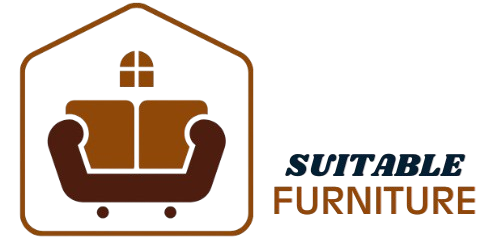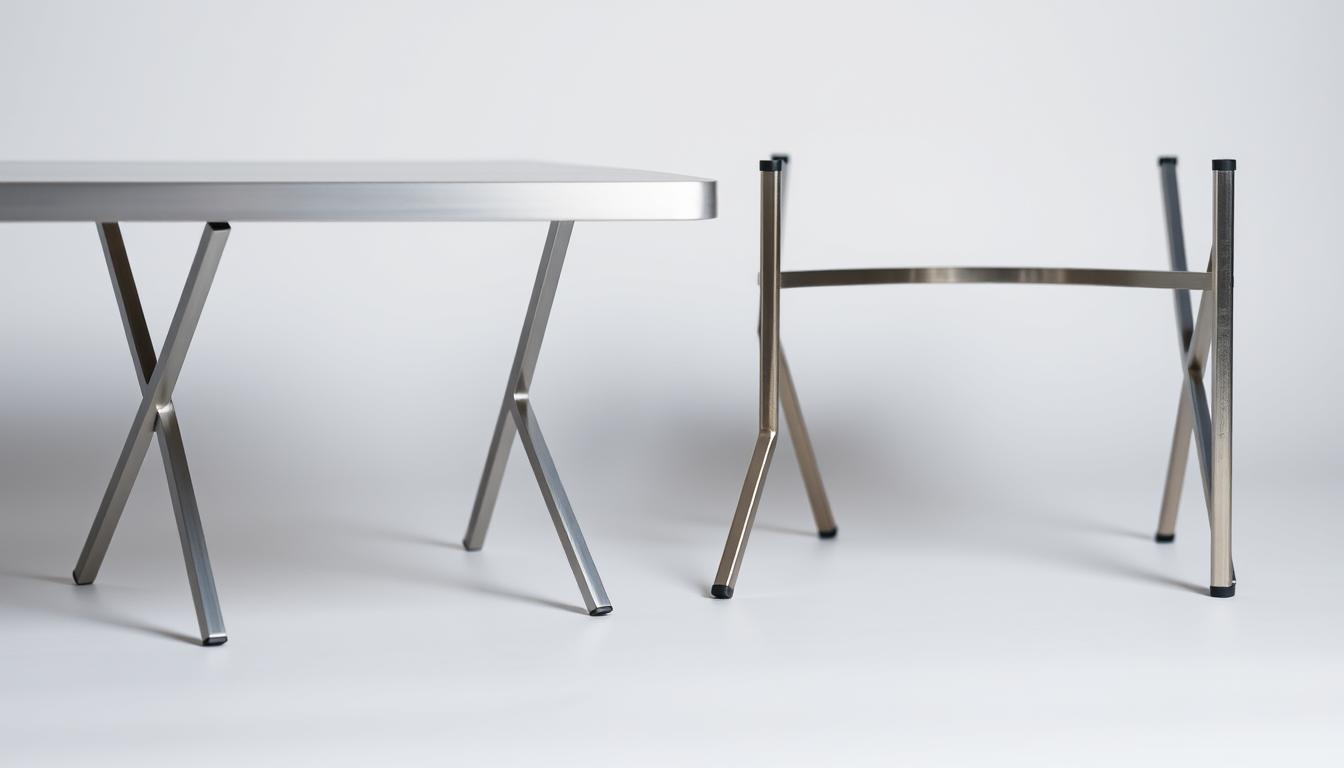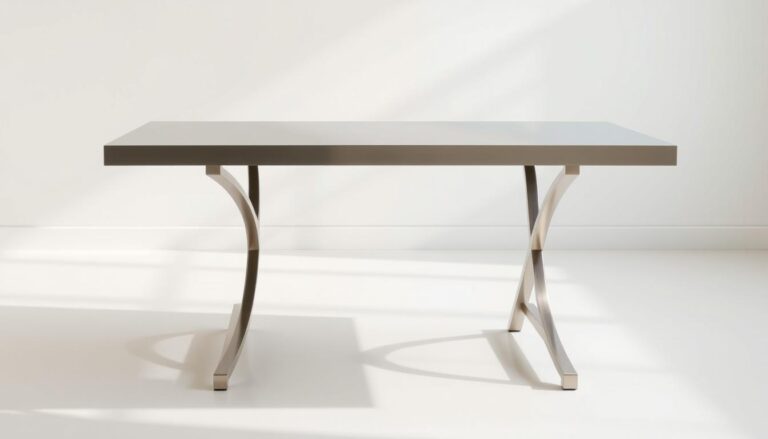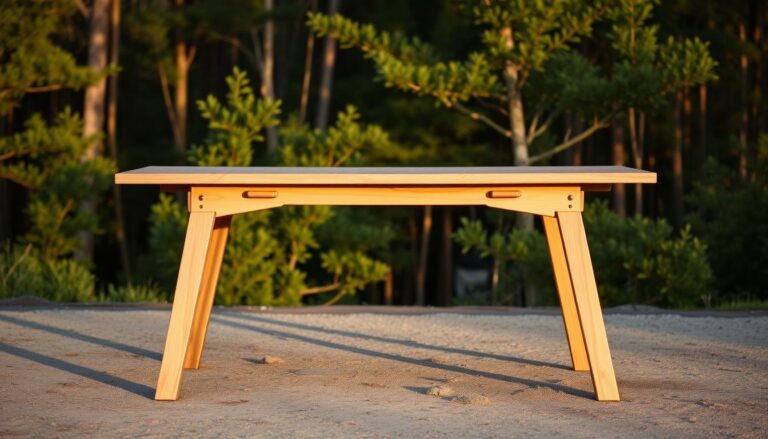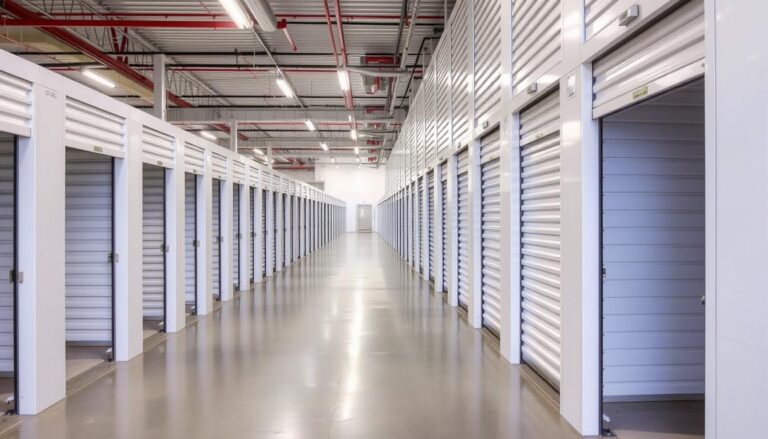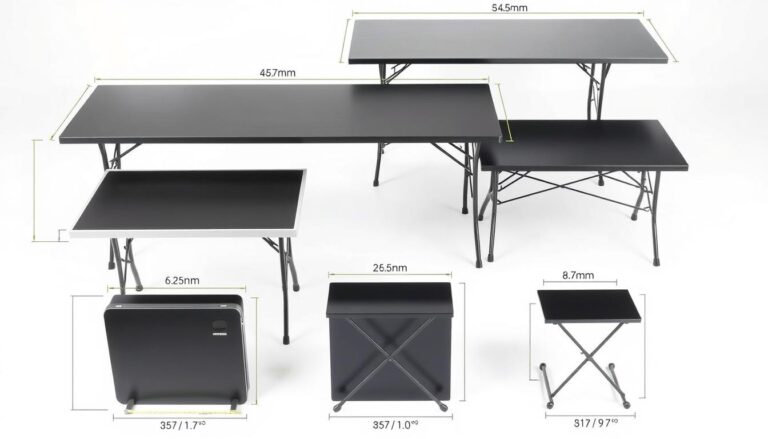Aluminum vs Stainless Steel Folding Tables: Which is Better?
Choosing the right folding table material can be tough. Do you need something durable, portable, or both?
The material you pick affects how long and how well your folding tables last. So, it’s key to compare aluminum and stainless steel.
Knowing what each material offers is vital. This article will guide you in picking the right one for your needs.
Key Takeaways
- Comparison of aluminum and stainless steel as materials for folding tables.
- Factors to consider when choosing the best material.
- Durability and portability considerations.
- Maintenance requirements for each material.
- Cost implications of choosing aluminum vs stainless steel.
Understanding Folding Table Materials
Choosing the right material for folding tables is key. It affects how well they work and how long they last. The material used in making a folding table greatly impacts its durability and usefulness.
The Importance of Material Selection
The material you pick changes how durable and commercial-grade a folding table is. Aluminum and stainless steel are top choices. They are strong and don’t rust easily.
Common Applications for Folding Tables
Folding tables are versatile and used in many places. They are great for events, offices, and homes. Their portability and simple setup make them perfect for short-term or seasonal needs.
| Material | Durability | Common Use |
|---|---|---|
| Aluminum | High | Events, Outdoor Use |
| Stainless Steel | Very High | Commercial, Heavy-Duty Use |
Key Factors in Decision Making
When picking a folding table, consider material, size, and weight capacity. Knowing these helps you choose the right table for your needs.
Aluminum vs Stainless Steel Folding Tables: A Comprehensive Comparison
Choosing between aluminum and stainless steel folding tables requires knowing their differences. Each material has its own benefits and drawbacks. It’s important to consider these when making a decision.
Key Differences at a Glance
The main differences between aluminum and stainless steel folding tables are in their materials and how they’re made. Aluminum folding tables are light and don’t rust, making them great for both inside and outside use.
Stainless steel folding tables are strong, last long, and can handle heavy loads. They’re perfect for places that need durability, like commercial and industrial settings.
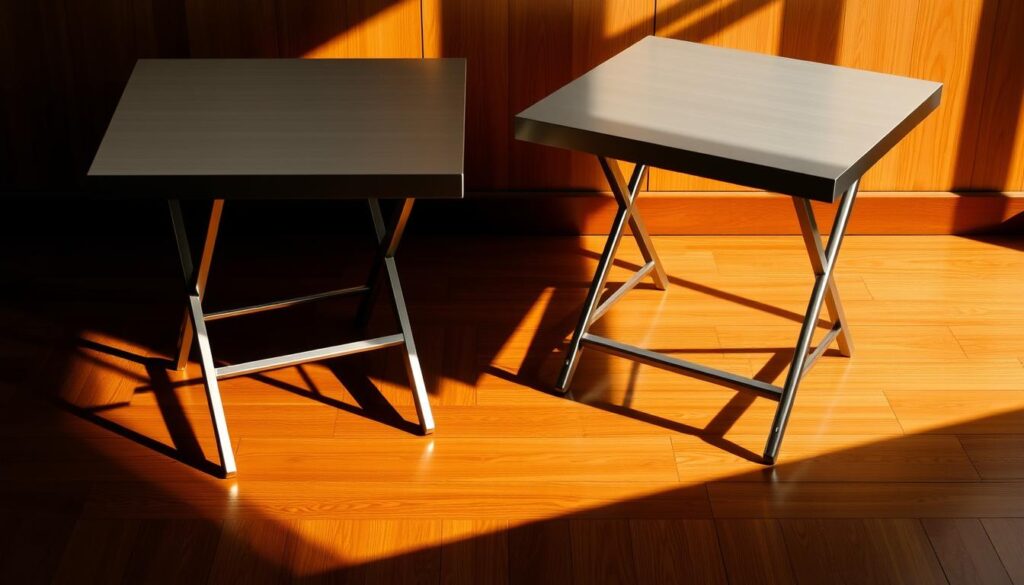
Material Properties Comparison
It’s important to compare the materials to see which folding table is best for your needs.
| Property | Aluminum | Stainless Steel |
|---|---|---|
| Weight | Lightweight | Heavier |
| Corrosion Resistance | High | High |
| Strength | Moderate | High |
| Cost | Generally Lower | Generally Higher |
Manufacturing Process Differences
The way aluminum and stainless steel folding tables are made is different. Aluminum tables are made using extrusion and welding, which allows for detailed designs and light weight.
Stainless steel tables need stronger making processes like cutting, welding, and polishing. This makes them durable but can make them more expensive to make.
Knowing these differences helps you choose the right folding table for your needs. Whether it’s for work, outdoor events, or home use.
Weight and Portability Factors
When it comes to folding tables, how easy they are to carry is very important. The weight of the material plays a big role. People often choose between aluminum and stainless steel tables based on how easy they are to move and set up.
Aluminum’s Lightweight Advantage
Aluminum folding tables are known for being lightweight. This makes them simple to carry around. They are perfect for events or places where tables need to be moved a lot.
Stainless Steel’s Weight Considerations
On the other hand, stainless steel folding tables are much heavier. This is because stainless steel is denser. While they are more stable, they are harder to move.
Impact on Transportation and Setup
The weight difference between aluminum and stainless steel tables affects how they are moved and set up. Lightweight aluminum tables can be carried by one person. But stainless steel tables might need more people or special tools to move.
| Material | Average Weight | Transportation Ease |
|---|---|---|
| Aluminum | 25 lbs | High |
| Stainless Steel | 50 lbs | Low |
Portability Features and Designs
Both materials have features that make them easier to carry, like folding and handles. But aluminum tables are generally easier to move because they are lighter.
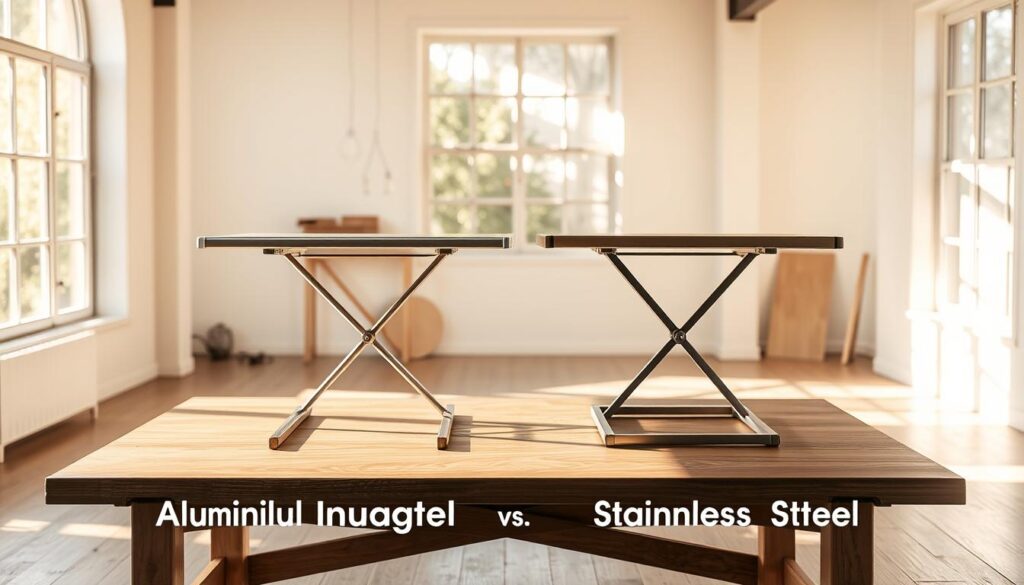
Durability and Strength Analysis
When choosing between aluminum and stainless steel folding tables, it’s important to look at their durability and strength. These factors affect how well the tables perform and last, especially in places where they are used a lot.
Load-Bearing Capacity Comparison
The load-bearing capacity is key to understanding a table’s durability. Aluminum folding tables can hold a lot of weight, but they’re not as strong as stainless steel tables. Stainless steel tables, on the other hand, are built to handle heavy loads, making them perfect for business and industrial settings.
Resistance to Physical Damage
How well a table can handle physical damage is also important. Aluminum tables are more likely to get dented or scratched. Stainless steel tables, however, are less likely to get damaged this way. But, stainless steel can still get scratched if it’s not finished right.
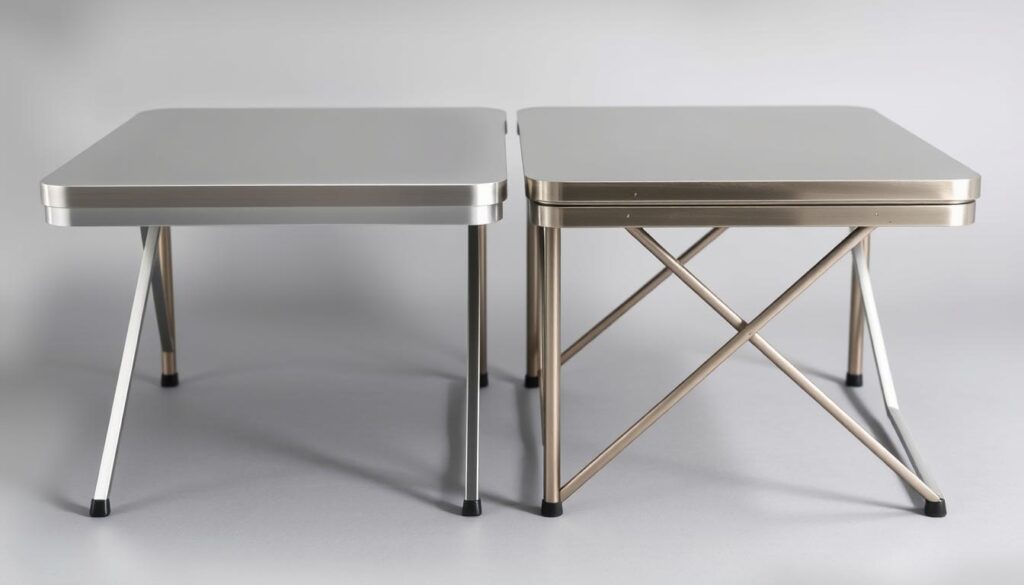
Long-Term Structural Integrity
The long-term strength of a folding table is crucial. Stainless steel tables stay strong over time, even when used a lot. Aluminum tables are also durable, but they might not stay as strong if they face harsh conditions or heavy loads.
Commercial-Grade Requirements
For tables used in businesses, durability and strength are must-haves. Stainless steel tables are often the top choice because they are stronger and last longer. Commercial-grade tables need to meet certain standards:
- High load-bearing capacity
- Resistance to physical damage
- Long-term structural integrity
- Easy maintenance and cleaning
Corrosion and Rust Resistance
Folding tables need to resist corrosion and rust to last long. Aluminum and stainless steel have special qualities that help them fight off corrosive elements.
Natural Oxidation Process of Aluminum
Aluminum forms a thin oxide layer when it meets air. This layer protects it from more corrosion. But, in tough conditions, extra coatings can boost its protection.
Stainless Steel Grades and Corrosion Resistance
Stainless steel stands out for its fight against corrosion, thanks to chromium. Different types of stainless steel offer different levels of protection. The right choice can make a big difference in harsh places.
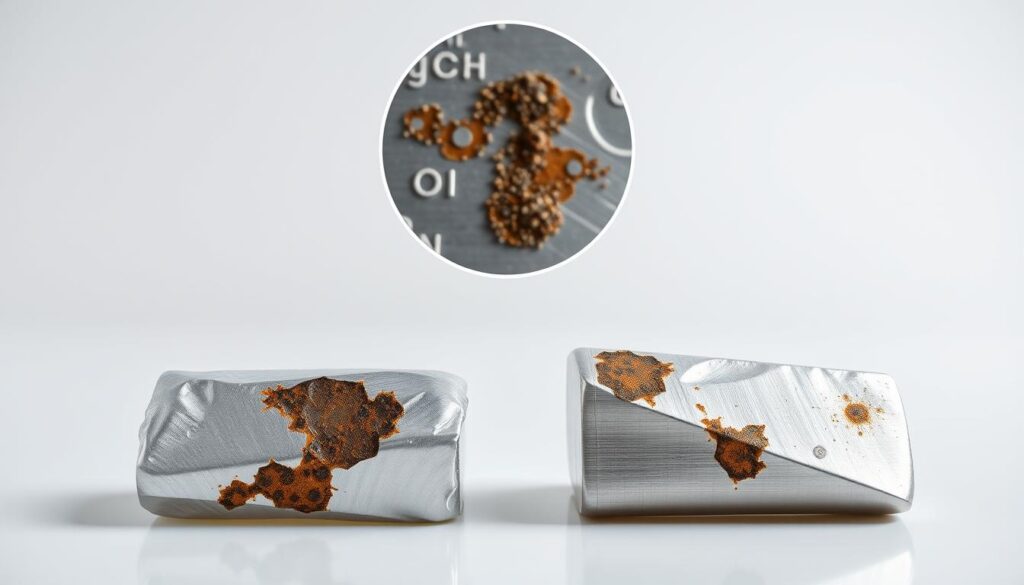
Performance in Harsh Environments
In places with lots of moisture, salt, or chemicals, both materials face a big test. Stainless steel usually wins, but top-notch aluminum can also do well.
Coastal and High-Humidity Considerations
When it’s wet or salty, picking between aluminum and stainless steel matters. Stainless steel is best for these areas because it fights off corrosive stuff better. But, coated aluminum can also work well.
Maintenance Requirements and Cleaning
The life of folding tables, whether made of aluminum or stainless steel, depends on how well they are maintained and cleaned. Taking care of them regularly not only makes them last longer but also keeps them looking great.
Day-to-Day Care for Aluminum Tables
Aluminum tables need a soft touch when cleaning. Use a soft cloth and mild soap to clean them. Stay away from harsh chemicals that can damage the protective layer on the aluminum.
Maintaining Stainless Steel Surfaces
Stainless steel tables are tough and don’t rust easily. Regular cleaning with a stainless steel cleaner keeps them looking good. Make sure to dry them after cleaning to avoid water spots.
Dealing with Scratches and Damage
Scratches on aluminum tables can be fixed with a gentle polish. For stainless steel, a scratch remover works well. Always follow the instructions on any repair products you use.
Professional Cleaning Methods
In places where tables are used a lot, like offices, professional cleaning is a good idea. They have the right tools and know-how to clean deeply without harming the tables. As one expert says,
“Regular professional cleaning can significantly extend the life of your folding tables.”
Aesthetic Appeal and Design Options
When choosing between aluminum and stainless steel folding tables, looks and design matter a lot. The right table can make any event or setting look better.
Aluminum Finish Varieties
Aluminum tables come in many finishes, from simple to fancy. These finishes make the table look good and last longer. Anodizing adds a protective layer, making it look sleek and shiny.
Stainless Steel’s Professional Appearance
Stainless steel tables have a sleek, professional look. Their shiny surface is perfect for places where looks matter, like offices or hotels. The professional look of stainless steel can make any space look better.
Customization Possibilities
Both aluminum and stainless steel tables can be made to fit your needs. You can choose different sizes, shapes, and finishes. For example, aluminum tables can be colored, and stainless steel tables can have special designs.
Matching with Different Environments
Both materials work well in many places. Aluminum tables are great outdoors because they’re light and don’t rust. Stainless steel tables are best indoors, where their sleek look can shine.
Cost Analysis: Initial Investment vs. Lifetime Value
When looking at folding tables, it’s key to think about both the upfront cost and the long-term benefits. This way, buyers can find a balance between what they can afford now and what they’ll need later.
Price Range Comparison
Aluminum folding tables are often cheaper to buy than stainless steel ones. This price gap comes from the materials and how they’re made. For example, aluminum tables can cost between $50 and $200, based on size and features. Stainless steel tables, however, can range from $100 to $500 or more.
Long-Term Value Assessment
Even though aluminum tables might be cheaper at first, stainless steel tables are more valuable over time. Tom Smith, a procurement manager, says, “Stainless steel tables cost more at the start, but they last longer and need less upkeep, making them a better deal in the long run.”
Return on Investment Considerations
When looking at the return on investment (ROI), several factors come into play. These include how long the table lasts, any upkeep costs, and if it can be sold or reused later. Stainless steel tables usually have a higher ROI because they last longer and need less care.
Budget-Friendly Options in Both Materials
For those with limited budgets, there are affordable choices in both aluminum and stainless steel. For instance, basic aluminum tables can be found for under $100, and entry-level stainless steel ones start around $150. It’s important to think about these costs against the table’s expected lifespan and value.
In summary, a detailed cost analysis goes beyond just looking at the initial price. It’s about understanding the total cost, including long-term value and ROI. By considering these aspects, buyers can make choices that fit their budget and needs.
Indoor vs. Outdoor Use Considerations
Choosing between aluminum and stainless steel folding tables depends on where you plan to use them. It’s important to think about indoor versus outdoor use.
Weather Resistance Comparison
Aluminum tables are better at handling weather because they naturally protect themselves from corrosion. Stainless steel tables are also durable but can corrode more easily, depending on their grade and the environment.
Temperature Sensitivity
Aluminum gets brittle in very cold temperatures. But stainless steel stays strong in a wider range of temperatures.
UV and Element Exposure Effects
UV rays and elements can damage both materials. Aluminum might need a special coating to prevent UV damage. Stainless steel, however, is generally more resistant to these effects.
Seasonal Storage Requirements
For outdoor use, storing tables during off-seasons is key. Aluminum tables are lighter and easier to store, making them a good choice for seasonal changes.
| Material | Weather Resistance | Temperature Sensitivity | Seasonal Storage Ease |
|---|---|---|---|
| Aluminum | High | Moderate | Easy |
| Stainless Steel | High (Grade-dependent) | Low | Moderate |
Best Use Cases and Applications
Choosing between aluminum and stainless steel folding tables depends on the setting. It’s not just about what looks good. It’s about what works best for the job.
Ideal Settings for Aluminum Folding Tables
Aluminum tables are great for places where you need to move things around easily. They’re perfect for events, outdoor fun, and schools. This is because they’re light and simple to set up and take down.
When to Choose Stainless Steel Tables
Stainless steel tables are best for places that need to last a long time. They’re good for hospitals, restaurants, and factories. This is because they’re strong and don’t rust easily.
Industry-Specific Recommendations
Every field has its own needs for folding tables.
Food Service and Catering
In the food world, stainless steel tables are top choice. They’re easy to clean and don’t rust. This keeps food areas clean and safe.
Educational and Institutional Settings
Schools like aluminum tables because they’re light. This makes them easy for everyone to move and store.
Event Planning and Rentals
For events, aluminum tables are the go-to. They’re easy to carry and set up fast. This is key for events that change quickly.
Healthcare Environments
In hospitals, stainless steel tables are the best. They’re tough and can handle lots of cleaning. This keeps the area clean and safe for patients.
| Industry | Recommended Material | Key Reasons |
|---|---|---|
| Food Service and Catering | Stainless Steel | Ease of cleaning, corrosion resistance |
| Educational and Institutional | Aluminum | Lightweight, easy to handle |
| Event Planning and Rentals | Aluminum | Portability, quick setup |
| Healthcare Environments | Stainless Steel | Durability, sterilizability |
Conclusion: Making the Right Choice for Your Needs
Choosing between aluminum and stainless steel folding tables needs careful thought. You must consider how you plan to use them, how long they’ll last, and your budget.
Looking at the good and bad points of each material helps you decide. This way, you can pick the best table for your needs. It doesn’t matter if it’s for indoor or outdoor events, or for home or business use.
The key is to think about what matters most to you. Do you want something light and strong, resistant to rust, and good-looking? Choosing the right table means it will serve you well for a long time.
It’s all about finding the right balance. You want to spend wisely but also get value for your money. Both aluminum and stainless steel tables can be great choices if you pick the right one for you.
